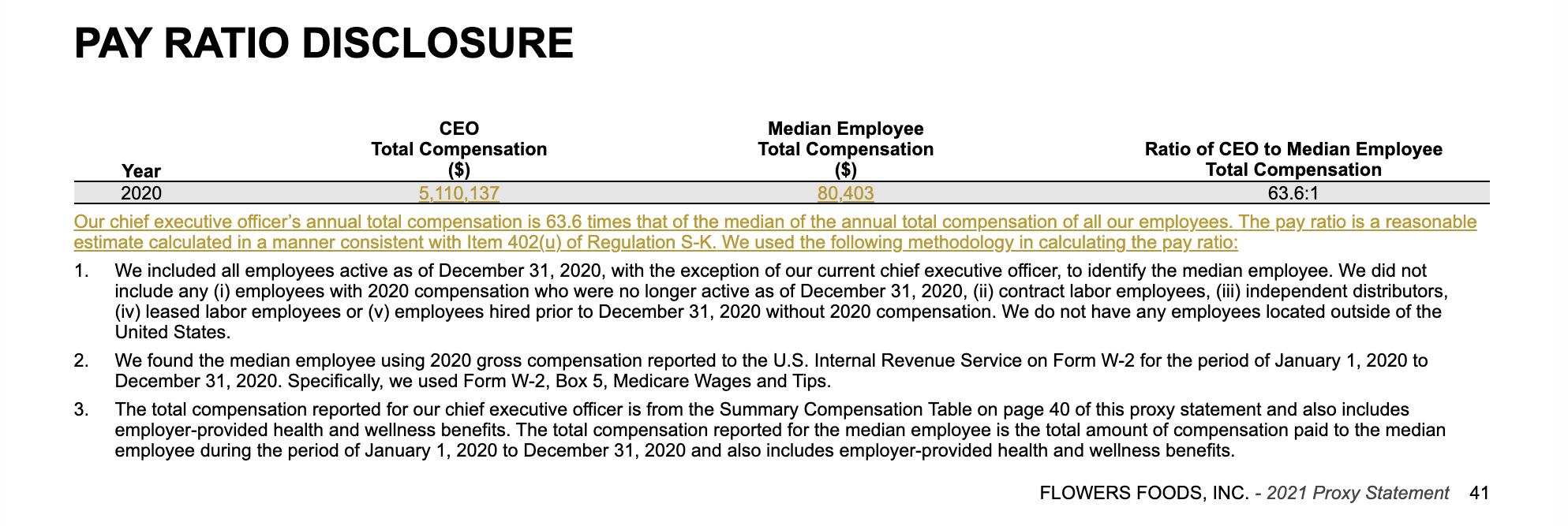Corporate America won’t start filing Q1 2021 earnings reports for a few more weeks yet, so the crack Calcbench research team decided to spend some time lately looking over corporate proxy statements for 2020 — which are arriving at a brisk pace these days.
That brings us to one of our favorite pieces of esoteric financial data: the CEO pay ratio!
For those unaware, the CEO pay ratio is a required disclosure for most U.S. public companies. It’s the ratio of total compensation for the CEO compared to the median total compensation of all other employees. The Securities and Exchange Commission began requiring CEO pay ratio disclosure for 2017 fiscal years, so this is now the fourth year of CEO pay ratio data we have.
Figure 1, below, is an example from Flowers Foods Inc. ($FLO), which filed its proxy statement on April 13.

The calculations are fairly straightforward. Total compensation for CEO Ryals McMullian was $5.11 million, and median employee total compensation was $80,400. So the CEO pay ratio was 63.6 to 1.
The more interesting details, as always, are the footnote disclosures underneath those numbers. As part of the disclosure, a firm must describe how it defined and calculated that median employee compensation number. For example, did the firm include contracted labor? (Not in Flowers’ case, apparently.) Did it include overseas employees, whose compensation might be much lower than that for U.S. employees, and therefore could skew the ratio to some unnatural extent? (Flowers has no overseas employees, so that’s not an issue here.)
The exact presentation of the CEO pay ratio can also vary. Look at the disclosure for Southern Co. ($SO), which filed its proxy statement on April 12, in Figure 2. All the necessary numbers are included, but you have to read the words to understand what’s what; no easy-to-read table presentation like Flowers gave in Figure 1.

If you can’t sufficiently squint, CEO Thomas Fanning had total compensation of $22.38 million in 2020, and median employee total compensation was $122,760 — for a CEO pay ratio of 134 to 1.
How Do You Find This Data?
Calcbench can help you find CEO pay ratio data in several ways. If you’re looking for data from a specific firm, start at our Interactive Disclosure page. Select “proxy” from our Choose Disclosure Type pull-down menu on the left side of the screen. Then do a text search for “ratio” and you should find the disclosure pretty quickly.
You can also search for CEO pay ratio disclosures in bulk on our Multi-Company page. Set the group of companies you want to search, and then enter “CEO Pay Ratio” in the standardized metrics field (because,yes, Calcbench tracks the pay ratio piece of data).
Figure 3, below, shows the CEO pay ratio for S&P 500 firms that have filed their 2020 proxy statements so far. As you can see, Starbucks ($SBUX) tops the list with a ratio of 1,657 to 1; followed by Coca-Cola ($KO) at 1,621 to 1.

Yes, you can also track the CEO pay ratio numbers for a firm over time — but beware the details! For example, changes in interest rate assumptions might push the costs of a CEO pension plan upward; or a decision to redefine a median employee (say, to include newly acquired employees in a low-cost overseas region) might push the median employee number downward.
The devil really is in the details for this particular number. Thankfully, Calcbench has all the details you want.